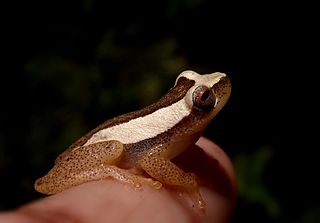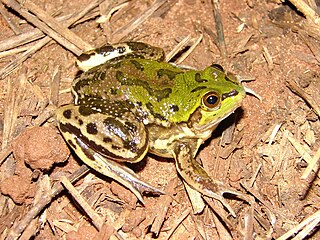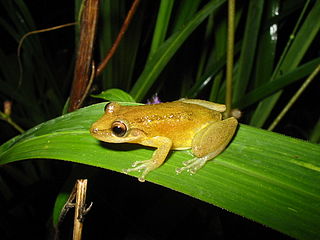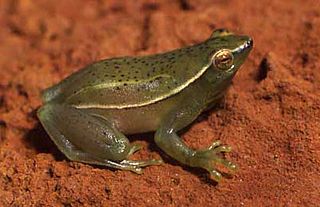
The canebrake tree frogs are a frog genus Aplastodiscus. They are in the family Hylidae. Residing primarily in southeast regions of Brazil near the Atlantic coast. The exception is the Aplastodiscus perviridis which is found mostly in Brazil, but has also been documented being in Argentina, and might reside in Paraguay. The major revision of the Hylidae genus expanded it to include 12 more species originally from Hyla. Before the revision there were only 2 species. There are currently 16 described species with the most recent addition Aplastodiscus heterophonicus being described in 2021.

Aplastodiscus albosignatus, also known as the Bocaina treefrog, is a species of frog in the family Hylidae. It is endemic to Brazil. Its natural habitats are subtropical or tropical moist lowland forests, subtropical or tropical moist montane forests, and rivers. It is threatened by habitat loss.

Aplastodiscus cochranae is a species of frog in the family Hylidae. It is endemic to the coastal mountains of Santa Catarina, Brazil. The specific name cochranae honors Doris Mable Cochran, an American herpetologist. Common name canebrake treefrog has been coined for this species.

Aplastodiscus leucopygius is a species of frog in the family Hylidae, endemic to Brazil. Its natural habitats are subtropical or tropical moist lowland forests, rivers, intermittent freshwater marshes, plantations, rural gardens, heavily degraded former forests, and irrigated land.

Aplastodiscus sibilatus is a species of frog in the family Hylidae. It is endemic to northeastern Brazil and is known from central-eastern Bahia and Alagoas. The specific name sibilatus is derived from the Latin sibilus meaning "whistle", in allusion to the characteristic call of the species.
Bokermannohyla pseudopseudis is a species of frogs in the family Hylidae. It is endemic to Brazil and is found in the northern Goiás state and the Federal District. It is sometimes known as the Veadeiros waterfall frog or Veadeiros treefrog.
Dendropsophus berthalutzae is a species of frog in the family Hylidae. It is endemic to southeastern Brazil and occurs in the coastal lowlands and the Serra do Mar in Espírito Santo, Minas Gerais, Rio de Janeiro, São Paulo, and eastern Paraná states. It is named in honor of Bertha Lutz, a Brazilian zoologist and feminist. Common name Bertha's treefrog has been coined for it.

Dendropsophus haddadi is a species of frog in the family Hylidae. It is endemic to eastern Brazil, with its distribution ranging from northern Espírito Santo to Bahia, Sergipe, Alagoas, Pernambuco. The specific name haddadi honors Célio F. B. Haddad, a Brazilian ecologist and herpetologist.
Boana beckeri is a species of frog in the family Hylidae. It is endemic to Brazil and is only known from a handful of localities in southern Minas Gerais and adjacent northeastern São Paulo. The specific name beckeri honors Johann Becker, Brazilian zoologist who collected many of the types.

Pseudis bolbodactyla is a species of frog in the family Hylidae. It is endemic to southern Brazil and occurs in Minas Gerais, southern Goiás, southern Bahia, and northern Espírito Santo states. Although it is currently considered a valid species, it has also been treated as a subspecies of Pseudis paradoxa.

Scinax fuscomarginatus is a species of frog in the family Hylidae. It is found in northwestern Argentina, Paraguay, eastern Bolivia, southern, central, and eastern Brazil, and in scattered localities in the lowlands of eastern Venezuela and savannas of Guyana and southern Suriname as well as adjacent Brazil. As currently defined, it is one of most widespread Neotropical frogs; the northernmost records refer to what was formerly recognized as Scinax trilineatus. Common name brown-bordered snouted treefrog has been coined for this species.

Sphaenorhynchus surdus, or Cochran's lime treefrog, is a species of frog in the family Hylidae. It is endemic to southern Brazil and is known from the eastern Paraná, Santa Catarina, and northeastern Rio Grande do Sul states. Before Sphaenorhynchus caramaschii was described in 2007, all Sphaenorhynchus from the south of the state of São Paulo state all way south to Rio Grande do Sul were identified as S. surdus.
Adenomera martinezi is a species of frog in the family Leptodactylidae. It is endemic to Brazil and only known from its type locality, Cachimbo in southwestern Pará. Prior to its redelimitation by Carvalho and Giaretta in 2013, it was believed to be more widespread. Populations of this widespread taxon are now recognized as a distinct species, Adenomera saci.
Ischnocnema sambaqui is a species of frogs in the family Brachycephalidae. It is endemic to the state of Paraná, Brazil, and known from the municipalities of Guaraqueçaba, Piraquara, and Morretes.
Phantasmarana lutzae is a species of frog in the family Hylodidae. It is endemic to Brazil and only known from its type locality in the Itatiaia National Park, Rio de Janeiro state. It is named in honor of Bertha Lutz, a Brazilian zoologist and feminist.

Bokermannohyla vulcaniae is a species of frogs in the family Hylidae. It is endemic to Brazil and only known from the region of its type locality in Poços de Caldas, Minas Gerais state. The specific name vulcaniae refers to the volcanic origin of the area of the type locality.

Dryaderces is a small genus of frogs in the family Hylidae. Their known distribution is disjunct, with one species found in the upper Amazon Basin and lower Andean slopes between central Peru and Amazonian Bolivia, and another one in Pará, Brazil. Its sister taxon is Osteocephalus. No phenotypic synapomorphies defining the genus are known.

Adenomera saci is a species of frog in the family Leptodactylidae. It is endemic to central-western and northern Brazil. Prior to its description by Carvalho and Giaretta in 2013, it was confused with Adenomera martinezi. The specific name saci is Portuguese word for a kind of whistling imp in Brazilian (Tupi) folklore, in allusion to the whistling call of this frog.
Scinax tigrinus is a frog in the family Hylidae. It is endemic to Brazil.

Pithecopus araguaius is a species of frog in the family Hylidae, endemic to Brazil. It has been observed in Mato Grasso. This frog has been observed 418 meters above sea level.














